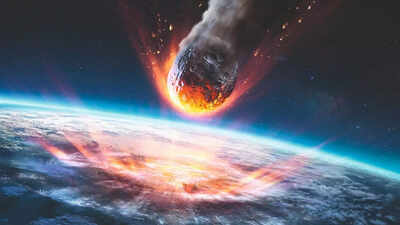NASA warns! 280-foot asteroid 2025 MA90 to make close Earth flyby today at 20,263 mph; here's what you must know | - The Times of India

An asteroid the size of a building, officially named
asteroid 2025 MA90
, is making a close approach to Earth, drawing global attention from scientists and space agencies. Though the flyby poses no threat, it offers a valuable opportunity to study how such near-Earth objects (NEOs) behave. With NASA confirming the asteroid’s safe distance and trajectory, and ISRO expressing renewed interest in planetary defence strategies, the event highlights the importance of early detection and international cooperation. As space agencies track and prepare for future events like Apophis 2029, the flyby of 2025 MA90 reminds us that cosmic vigilance is essential.
An asteroid nearly the size of a city building is heading toward Earth, sparking interest but not alarm among scientists. Known as asteroid 2025 MA90, this space rock is being closely monitored as it prepares for a safe flyby on July 15. Measuring approximately 280 feet across and traveling at an impressive 20,263 miles per hour, MA90 is expected to pass by Earth at a distance of about 4 million kilometers. Though the approach is relatively close in cosmic terms, NASA confirms there is no risk of impact. The event serves as a reminder of our planet’s vulnerability—and our increasing readiness.According to NASA, asteroid 2025 MA90 is classified as a member of the Aten group of asteroids—a class of near-Earth objects that orbit the Sun and sometimes cross Earth’s orbit. However, this particular asteroid does not meet the criteria to be considered potentially hazardous. For an object to qualify as hazardous, it must be at least 85 meters wide and come within 7.4 million kilometers of Earth. While MA90 meets the size threshold, its projected flyby distance of approximately 4,020,000 kilometers places it safely outside the danger zone.
NASA’s scientists continue to track the asteroid’s trajectory for any changes, as even minor orbital shifts can affect long-term calculations. Nevertheless, this flyby offers a valuable opportunity for astronomers to study its movement, composition, and behavior in more detail using ground-based and radar observations. Though 2025 MA90 is not a threat, the incident reflects why tracking near-Earth objects (NEOs) is crucial for planetary defence. Even objects that miss Earth can reveal critical data about asteroid orbits, spin rates, and composition. These insights are vital for preparing for potential future threats.NASA and other space agencies around the world maintain extensive monitoring systems to catalog thousands of such asteroids, identifying any that may warrant further observation or mitigation strategies. This proactive approach aims to ensure that humanity is never caught off guard by a surprise impact.
While the focus now is on MA90, India’s space agency ISRO has its eyes on a much larger and more complex challenge—the anticipated 2029 flyby of asteroid Apophis. This massive near-Earth object, measuring over 1,200 feet in diameter, will pass alarmingly close to Earth, within a distance of about 32,000 kilometers—closer than many satellites.ISRO Chairman S. Somanath has stressed the importance of collaborative global action to address such cosmic threats. He advocates for deeper cooperation between ISRO, NASA, ESA (European Space Agency), and JAXA (Japan Aerospace Exploration Agency). Together, these agencies can lead planetary defence missions that include impact deflection tests and potentially even asteroid landings. ISRO is reportedly developing missions that could involve landing on an asteroid, a bold step that would allow scientists to study their surfaces and structure directly.
The peaceful flyby of asteroid 2025 MA90 should not overshadow the growing urgency in space science to build robust defence strategies. With the increasing detection of NEOs, the global community recognizes that Earth is not immune to cosmic hazards. Events like the Chelyabinsk meteor in 2013 have shown how even small asteroids can cause significant damage.Thus, every close encounter becomes both a warning and a learning opportunity.Also Read| Shubhanshu Shukla to return Earth after historic ISS mission; know what he achieved through space experiments
You may also like...
Diddy's Legal Troubles & Racketeering Trial

Music mogul Sean 'Diddy' Combs was acquitted of sex trafficking and racketeering charges but convicted on transportation...
Thomas Partey Faces Rape & Sexual Assault Charges

Former Arsenal midfielder Thomas Partey has been formally charged with multiple counts of rape and sexual assault by UK ...
Nigeria Universities Changes Admission Policies

JAMB has clarified its admission policies, rectifying a student's status, reiterating the necessity of its Central Admis...
Ghana's Economic Reforms & Gold Sector Initiatives

Ghana is undertaking a comprehensive economic overhaul with President John Dramani Mahama's 24-Hour Economy and Accelera...
WAFCON 2024 African Women's Football Tournament

The 2024 Women's Africa Cup of Nations opened with thrilling matches, seeing Nigeria's Super Falcons secure a dominant 3...
Emergence & Dynamics of Nigeria's ADC Coalition

A new opposition coalition, led by the African Democratic Congress (ADC), is emerging to challenge President Bola Ahmed ...
Demise of Olubadan of Ibadanland
Oba Owolabi Olakulehin, the 43rd Olubadan of Ibadanland, has died at 90, concluding a life of distinguished service in t...
Death of Nigerian Goalkeeping Legend Peter Rufai

Nigerian football mourns the death of legendary Super Eagles goalkeeper Peter Rufai, who passed away at 61. Known as 'Do...



